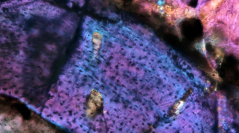

 Comptes Rendus Palevol
11 (6) - Pages 419-433
Comptes Rendus Palevol
11 (6) - Pages 419-433Procolophonoidea represent the most successful radiation of Parareptilia that lived during the Permo-Triassic. They are one of the few vertebrate groups that survived the end-Permian extinction and are thus important for studying the recovery of the post-extinction terrestrial ecosystem. Here, we investigate the palaeobiology of three Triassic procolophonid parareptiles, namely Sauropareion anoplus, Procolophon trigoniceps and Teratophon spinigenis, from the Karoo Basin of South Africa, inferred from histological analyses of their limb bones. Results reveal that all three taxa exhibit parallel-fibered bone tissue. Growth rings are absent in the Early Triassic Sauropareion and Procolophon whereas annuli are present in the Middle Triassic Teratophon, even during early ontogeny, suggesting a difference in life histories. Morphology and bone histology imply fossorial lifestyles for all three taxa, suggesting that burrowing may have played an important role in their survival during the harsh post-extinction Triassic environment.
Procolophonidae, Procolophonid, Bone histology, End-Permian extinction, South Africa, Karoo Basin